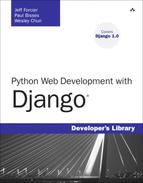Book Description
Using the simple, robust, Python-based Django framework, you can build powerful Web solutions with remarkably few lines of code. In Python Web Development with Django®, three experienced Django and Python developers cover all the techniques, tools, and concepts you need to make the most of Django 1.0, including all the major features of the new release.
The authors teach Django through in-depth explanations, plus provide extensive sample code supported with images and line-by-line explanations. You’ll discover how Django leverages Python’s development speed and flexibility to help you solve a wide spectrum of Web development problems and learn Django best practices covered nowhere else. You’ll build your first Django application in just minutes and deepen your real-world skills through start-to-finish application projects including
Simple Web log (blog)
Online photo gallery
Simple content management system
Ajax-powered live blogger
Online source code sharing/syntax highlighting tool
How to run your Django applications on the Google App Engine
This complete guide starts by introducing Python, Django, and Web development concepts, then dives into the Django framework, providing a deep understanding of its major components (models, views, templates), and how they come together to form complete Web applications. After a discussion of four independent working Django applications, coverage turns to advanced topics, such as caching, extending the template system, syndication, admin customization, and testing. Valuable reference appendices cover using the command-line, installing and configuring Django, development tools, exploring existing Django applications, the Google App Engine, and how to get more involved with the Django community.
Introduction 1
Part I: Getting Started
Chapter 1: Practical Python for Django 7
Chapter 2: Django for the Impatient: Building a Blog 57
Chapter 3: Starting Out 77
Part II: Django in Depth
Chapter 4: Defining and Using Models 89
Chapter 5: URLs, HTTP Mechanisms, and Views 117
Chapter 6: Templates and Form Processing 135
Part III: Django Applications by Example
Chapter 7: Photo Gallery 159
Chapter 8: Content Management System 181
Chapter 9: Liveblog 205
Chapter 10: Pastebin 221
Part IV: Advanced Django Techniques and Features
Chapter 11: Advanced Django Programming 235
Chapter 12: Advanced Django Deployment 261
Part V: Appendices
Appendix A: Command Line Basics 285
Appendix B: Installing and Running Django 295
Appendix C: Tools for Practical Django Development 313
Appendix D: Finding, Evaluating, and Using Django Applications 321
Appendix E: Django on the Google App Engine 325
Appendix F: Getting Involved in the Django Project 337
Index 339
Colophon 375
Table of Contents
- Copyright
- Developer’s Library: Essential References for Programming Professionals
- Preface
- Welcome to Django!
- About This Book
- Chapter Guide
- Part I, “Getting Started”
- Chapter 1, “Practical Python for Django”
- Chapter 2, “Django for the Impatient: Building a Blog”
- Chapter 3, “Starting Out”
- Part II, “Django in Depth”
- Chapter 4, “Defining and Using Models”
- Chapter 5, “URLs, HTTP Mechanisms, and Views”
- Chapter 6, “Templates and Form Processing”
- Part III, “Django Applications by Example”
- Chapter 7, “Photo Gallery”
- Chapter 8, “Content Management System”
- Chapter 9, “Liveblog”
- Chapter 10, “Pastebin”
- Part IV, “Advanced Django Techniques and Features”
- Chapter 11, “Advanced Django Programming”
- Chapter 12, “Advanced Django Deployment”
- Part V, “Appendices”
- Appendix A, “Command Line Basics”
- Appendix B, “Installing and Running Django”
- Appendix C, “Tools for Practical Django Development”
- Appendix D, “Finding, Evaluating, and Using Django Applications”
- Appendix E, “Django on the Google App Engine”
- Appendix F, “Getting Involved in the Django Project”
- Conventions
- Book Resources
- Chapter Guide
- Acknowledgments
- About the Authors
- Introduction
- I. Getting Started
- 1. Practical Python for Django
- Python Skills Are Django Skills
- Getting Started: Python’s Interactive Interpreter
- Python Basics
- Python Standard Types
- Flow Control
- Exception Handling
- Files
- Functions
- Object-Oriented Programming
- Regular Expressions
- Common Gotchas
- Coding Style (PEP 8 and Beyond)
- Summary
- 2. Django for the Impatient: Building a Blog
- 3. Starting Out
- 1. Practical Python for Django
- II. Django in Depth
- 4. Defining and Using Models
- 5. URLs, HTTP Mechanisms, and Views
- 6. Templates and Form Processing
- III. Django Applications by Example
- IV. Advanced Django Techniques and Features
- 11. Advanced Django Programming
- 12. Advanced Django Deployment
- V. Appendices
- A. Command Line Basics
- B. Installing and Running Django
- C. Tools for Practical Django Development
- D. Finding, Evaluating, and Using Django Applications
- E. Django on the Google App Engine
- F. Getting Involved in the Django Project
- Colophon
